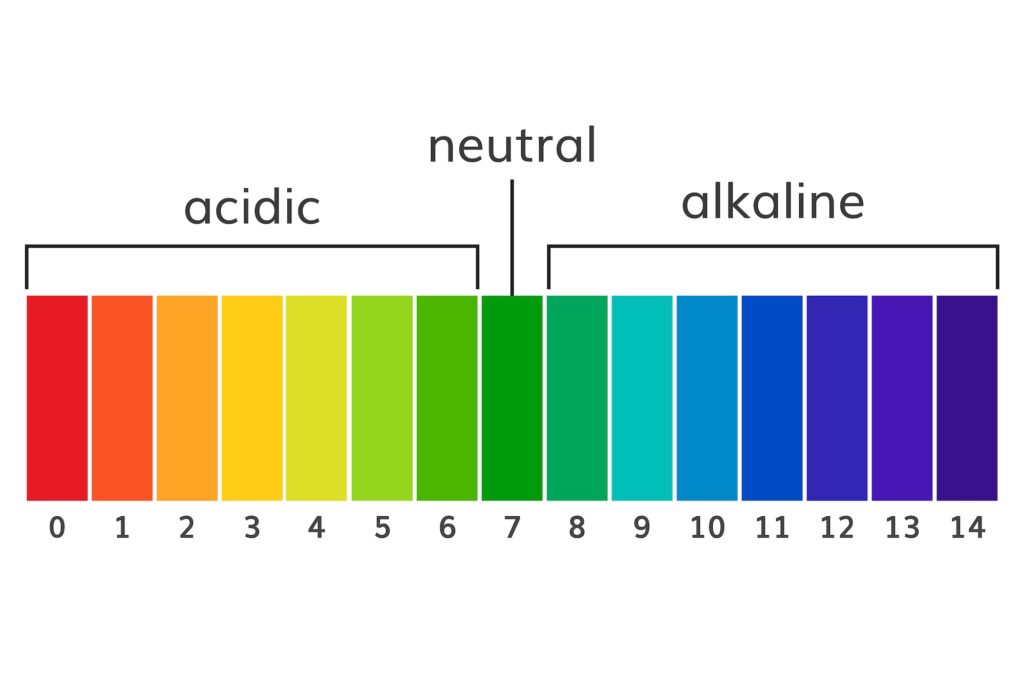It’s been brought to my attention more than once recently that greenkeepers are being advised to lime their greens. At first glance, it sounds harmless. Logical even. The soil’s too acidic? Add lime. Problem solved. But is it?
I don’t think so and I’d go as far as saying that this advice is at best ill informed and, in most cases, inviting trouble.
I say this because such advice seems to be based on a narrow, agricultural view of temporary soil correction and is not sports turf specific. Turfgrass management is not the same as farming, yet this type of advice seems rooted in conventional agriculture, where temporary fixes for recurring symptoms or problems are applied to accommodate a range of crops and field uses.
Worst of all probably is that liming advice completely overlooks the dangers associated with adding lime to a fine turf surface.
What does pH actually mean?
The pH scale runs from 0 to 14 (very acid to very alkaline) and 7 is said to be neutral or neither acid or alkaline. Our fine perennial grasses like the soil to be somewhere between 5.5 and 6.5, slightly acid.
The general understanding of pH then, is that it tells you whether your soil is Acid, Alkaline or Neutral and to be fair this is true. However, the underlying chemistry is more complex than that and as greenkeepers it’s useful for us to know a little about this.
The Potential of Hydrogen (pH)
pH stands for the Potential of Hydrogen, so the pH section of your greens soil analysis is all about Hydrogen. In fact a measure of the number of exchangeable Hydrogen Ions in the soil. An atom of any element has an equal number of protons and electrons. An Ion is simply an atom with an imbalance of these, usually due to losing or gaining electrons. This imbalance gives the ion an electrical charge which can be negative or positive in polarity. Acidic soil contains more hydrogen ions (H+) than neutral or alkaline soil. Positively charged ions like H+ are referred to as Cations (positively charged ions), whilst negatively charge ones are called Anions.
The Soil Colloid
Fully stable humus and clay particles within the soil are collectively known as the Soil Colloid and this is where all of the soil chemistry happens. Crucially, these microscopic particles of clay and humus are negatively charged, which means that positively charged Ions like Hydrogen (H+) and Aluminium (Al³⁺) find it relatively easy to take hold on the Colloid and will dominate if conditions are right for them, making the soil increasingly acidic.
When working with biologically active soils, pH is often lower in the rhizosphere around the plant roots where bacteria metabolise on the root exudates and produce organic acids. However, in soils with an alkaline pH, (greater than 7), some nutrient elements such as phosphate and manganese can become unavailable to the plants or locked up as it’s sometimes referred to. You will often have heard that the optimum pH for turfgrass is 5.5 to 6.5 and there’s a good reason for this. Slightly acidic root zones favour the development of fungal hyphae in the presence of the correct food sources. Fungi are important for thatch degradation, disease suppression and perennial grass growth. This slightly acid environment is created and driven by the plants themselves to favour the plant beneficial microbes they co-exist with.
Why Soil pH Drops out of the ideal zone
As standard soil analysis offerings are focussed solely on soil chemistry, a very low pH is often interpreted as a chemical imbalance, which, of course, it is. The question of why those acid cations are dominant on the soil colloid remains unaddressed in most cases, however. Instead it seems that many advisers are jumping straight to the temporary, artificial correction advice to add lime, and, for fine turf, that can be dangerous advice.
In bowling green rootzones, the answer to low pH is often biological and structural, rarely chemical. These conditions encourage acidity, not because the turf needs lime but because the soil ecosystem is being choked of oxygen. Hydrogen isn’t dominating the exchange sites just because there’s not enough calcium. It’s dominating because the soil is in poor condition and lacks the biological processes needed to buffer and self correct the pH naturally.
This will often show up on a soil test as high readings for metals such as zinc, copper and iron and will usually be accompanied by high readings for Electrical Conductivity (EC), sulphate, and of course, low pH. In these cases, you will regularly find a build up of thatch at the surface and/or layers of old, un-decomposed thatch, buried under sand top-dressings, with black layers being common too.
Why liming regularly backfires
When lime is applied, it reacts with the hydrogen ions in the soil, neutralises some of them, and raises the pH, so you might conclude that the job is done…next.
Liming is essentially an artificial fix. It does nothing to address the underlying structural or biological dysfunction in the rootzone. It’s often temporary, especially in sandy, low-buffering soils and worst of all, it will often trigger an outbreak of Take-All Patch, which can cause greenkeeping headaches for years after the initial outbreak.
In a fine perennial sward of fescue and bent grasses, a sudden jump in pH can send the microbial balance into chaos. Pathogens that were being held in check by the perennial grasses’ preferred soil acidity (pH 5.5 to 6.5) and by beneficial fungi and bacteria, can suddenly be presented with an open goal and will often take advantage. Many of the key organisms in a healthy turfgrass soil food web, such as mycorrhizal fungi and actinomycetes, thrive in well-aerated, moderately acidic environments. A sudden spike in pH, especially near the surface, can disrupt the microbial community, reducing biological diversity and tipping the balance in favour of opportunistic pathogens such as Take All Patch or less beneficial decomposers. This destabilisation weakens the natural disease suppression mechanisms of the soil.
What you can be left with is a chemically corrected soil that’s biologically unstable, a recipe for problems.
Biological Restoration of pH to the ideal range.
So, if liming is out — what’s in?
You could call it biological restoration of pH balance if you wanted to impress the club committee, but it’s really just allowing for the exchange of gasses from the soil to and from the environment outside…in other words oxygenation of the soil. In fact, in a core sample showing a black layer or layers from a green affected in this way, you can observe the oxygen doing its work, as the black layer will quickly disappear if you leave the core lying on the green surface for 20 minutes or so.
So, instead of trying to fix the pH from the outside in, we start from the inside, with the soil biology. That means:
- Aerating the turf to reintroduce oxygen and shift the chemistry away from reductive, acid-forming processes
- Reducing thatch and anaerobic layering, through renovation practices such as pencil tining or hollow coring
- Feeding the soil life with carbon-based biostimulants, microbial inoculants, and organic inputs that encourage fungi and humus formation. Avoiding pesticide and high salt synthetic fertiliser is important too.
- Allowing nature to re-establish its own buffering system — particularly through the cycling of calcium, magnesium, and potassium via microbial and root activity
This isn’t about bypassing chemistry, it’s about grounding your greenkeeping in nurturing the soil biology.
Be Informed by your Soil Analysis…not Confused!
Bowling green maintenance can be a complex occupation and to make sure you are following the correct path, you need good information about your green’s overall condition. A lot is made of Soil Chemistry as we have seen in this article, but very little is mentioned about the Physical condition of the soil and almost nothing is considered or determined through the lens of Soil Biology, which ironically is the aspect of soil science that drives the turf eco-system to produce a consistently high performance surface that is manageable and affordable for amateur or part time greenkeepers with the resources available within most bowling clubs in the British Isles.
Personal Service
Many of the soil analysis services available in our industry produce almost worthless sheets of paper detailing a few of the key nutrients and pH, with no real interpretation of what that means for your green. I believe that bowling clubs need a better service than this and strive to provide it. Every single soil analysis purchased on bowls central receives my personal attention. I analyse the lab results, interpret what they mean for you and suggest the work you need to be doing on your green to make improvements. My soil analysis services don’t just pump out a page full of computer generated numbers about soil chemistry; they also include details of the soil texture in your green as standard, and interpret what this means for the all important Soil Biology. Every report includes a 12 month maintenance programme created for your green to help you make improvements that build toward a more reliable and predictable green that performs better in the longer term. Your report also takes into account the ever changing environmental conditions we are experiencing, helping you, even if you are an experienced greenkeeper, to adapt your maintenance practices to counteract the hotter, wetter and extreme weather events that are becoming more common, preserving often precious water resources and dealing with the new pressures all of this brings.


